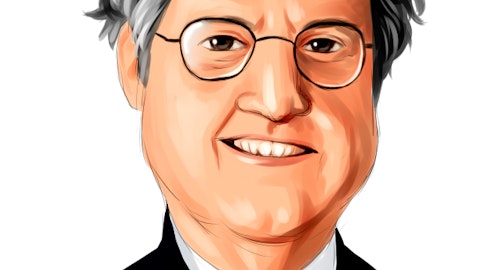Helen Sabzevari : So in this trial, actually, based on our prior trials, we are — there is a two dose cohort here. However, this is an umbrella trial, as we have mentioned before that basically means we are addressing a number of indications, both hematological as well as solid tumor, especially triple-negative breast cancer, this can be very exciting. And what we are looking and the guidance that we have given, we will be giving some updates on the interim data by the end of 2024. And we will be moving upon the dose selection as well, obviously, finishing all of the safety, then the trial moves to the expansion phase, Phase 1b. And again, those are the discussions that based on the data that we will see, we will have with the regulatory body the similar type of things as we currently have it, for instance, our AML, which is in a patient population that they really have no other option in front of them.
And as you are aware, other CAR-Ts and TCRs have not been able or even the off-the-shelf have not been able to enter into that arena. And also a small molecule inhibitors, unfortunately, address only certain percentage, 6% to 7% of the patients that they have those mutations, for instance, inflectary. And as we have seen based on the data, those patients, unfortunately, after a year also there is a mutation in their tumors and they relapse and they have to look for other options. So I think we are really excited about that and our CAR-T and the results that have been showing, and then we will be — as we have given the guidance, by the end of 2024, we will present the data on expansion.
Operator: Your next question comes from Brian Cheng from JPMorgan.
Brian Cheng : First one is on your — first one is on the RRP platform. So based on your market research, how should we think about the initial adoption trajectory within RRP, if you were approved today? Is there a lot of pent-up demand or do you think that this will be a small build over time type of launch? And I have a quick follow-up.
Helen Sabzevari : I think, Brian, I’m going to let Jim Shaffer answer that and I can add to that as well.
Jim Shaffer: Sure. As I mentioned earlier, we recently completed a commercial market assessment for the U.S. and the rest of the world markets for RRP and for PRGN-2012. We feel like the overall uptake is going to be relatively swift because a large majority of the patients are sitting and managed by a relatively small number of laryngologists across the U.S. So as we educate and increase awareness about the product availability, we think that’s going to be relatively quick with those physicians and patients. So whether it’s a three or four year uptake curve to peak, and then with some level of retreatment that occurs for the rest of the overall sales build over time. Does that answer your question?
Brian Cheng : Yes, it does. So on the — maybe just on expenses, how should we project sales-related expenses as you prepare for the launch? Any color on the projected cash runway? And what is the latest update on the partnership for UltraCAR-T?
Helen Sabzevari : So I can take some of this, and then definitely, Harry can add to it. In regard to our — as Harry mentioned, we are looking at the various strategies for basically supplementing our financial balance sheet and we are confident that we — as we move forward, we have that ability. In regard to the UltraCAR-T, actually, I’m glad you asked that question, because as you can imagine, especially with the evolution and the scenarios that have happened, we saw all in the past six months the change of the label even in approved CAR-T for the reason that the classical CAR-T, unfortunately, some of the patients have come down with cancers of associated with the CAR-T. And now that has to be projected in the label at the same token.
Now this puts another cloud on the field of autoimmunity using this classical CAR-T, because in a cancer patient, of course, you’re dealing with indication that the patients have no option and they have no other treatment. On the other hand, when you are looking at the chronic diseases such as lupus or autoimmunity clearly, now you have to have a very, very safe drug. Because number one, these are not patients that are Stage 4. These are patients that they can live for a long period of time. And secondly, most probably, they have to be redosed over their chronic disease. So you in that setting, you have to have two phenomenon: Number one, the safety to ensure that someone that would have had otherwise a long life, you cannot be exposing to the scenario that they might develop cancer as a result of the treatment that they receive.
Number two, is the cost, it becomes very, very important, especially in chronic diseases. Because as we can see, currently, even the cost in a cancer indication is not bearable on our system left alone, now you go to the chronic diseases. For those reasons, the platform that we have developed and it’s moving forward. And by the way, across the indication, we have now treated more than 70 patients in this platform. And number one, the ease of the manufacturing overnight at the hospital, which then does not require the costs that are associated, as you can imagine, with centralized manufacturing. And number two, the design of these CAR-Ts that we have currently, which do carry safety switches within that, with under — if anything goes wrong, you can eliminate these stuff.
Thankfully, we have not to activate these cells, but obviously, we have done all of the preclinical studies, and of course, these were part of our IND package that was given to FDA. And I think this is the advantage that, currently, our CAR-T and the combination of those two factors, obviously, have created a lot of excitement and also attention. So we will be updating as we move forward in regard to our basically partnership activity, but this is going to be a very exciting year.



